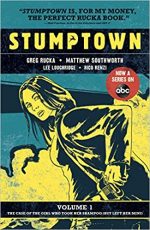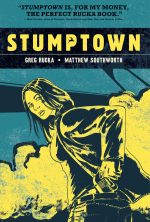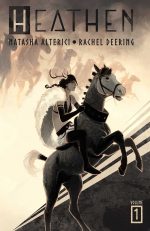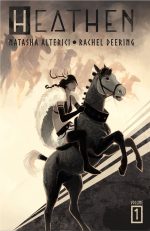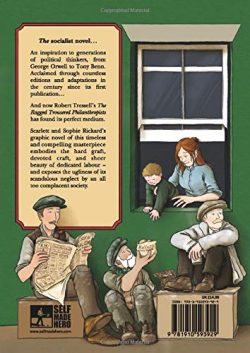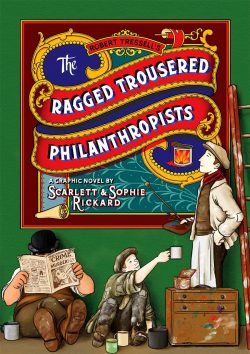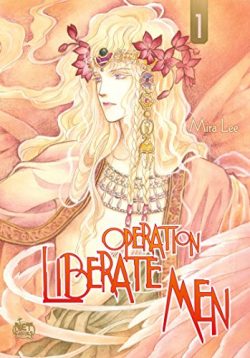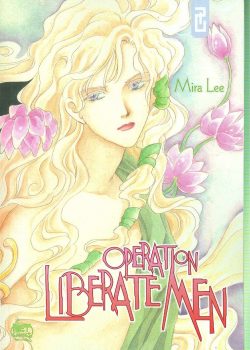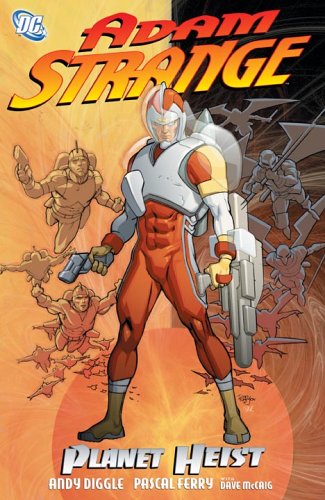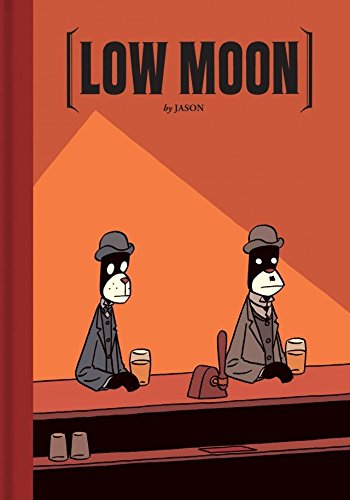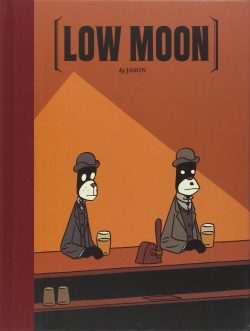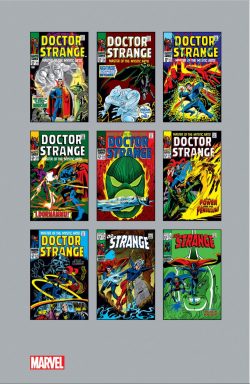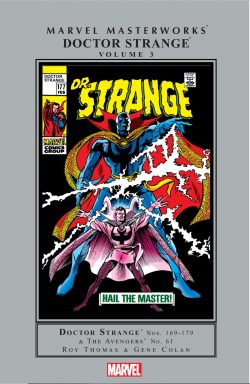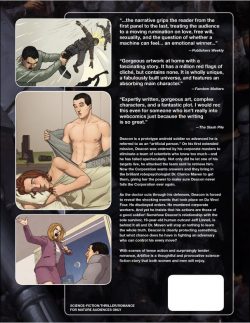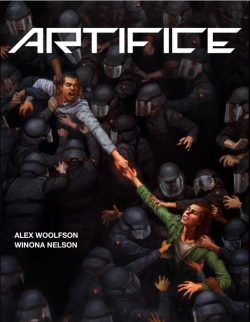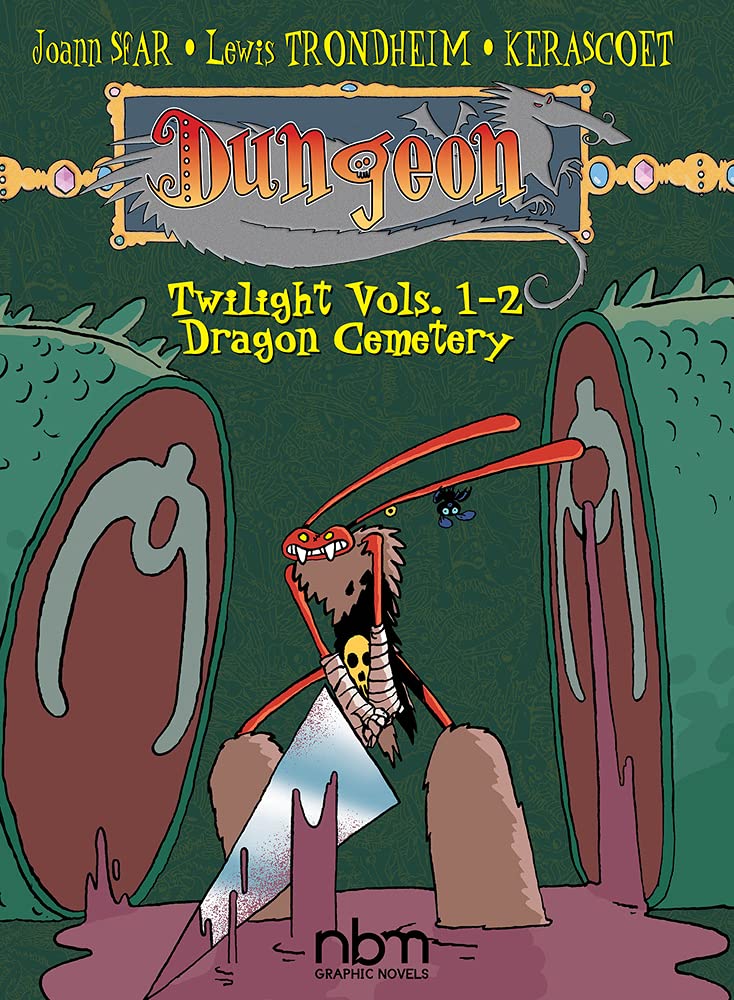
By Joann Sfar, Lewis Trondheim & Kerascoet, translated by Joe Johnson (NBM)
ISBN: 978-1-68112-293-9, (TPB/Digital)
Somewhere way out there, is a planet called Terra Amata. On this populated world of rich history and diverse ways of life, there’s a magic castle in a fantastic land of miracles, quests and adventures. There was once also a rather dangerous meeting place called the Dungeon…
As primarily crafted by prolific artisans Joann Sfar (Le Ministère secret, Professeur Bell, Les olives noires, The Rabbi’s Cat) and Lewis Trondheim (Kaput and Zösky, Little Nothings, Stay, Ralph Azham) in collaboration with assorted associates of their New Wave-ish collective of bande dessinée creators (most often seen under the aegis of L’Association) – the Donjon saga has generated more than fifty volumes since debuting in 1998 and become a cult hit all over the world. It began as a fanciful spoof/parody of roleplaying fantasy games, but as so often with stories of innate charm and high quality, it grew beyond its intentions…
After a cruelly long hiatus, English translations of the epic are at last returned. Repackaged in the first of a series of full-colour paperback collections, the initial quartet of the Donjon Crepuscule series have been rereleased for your delight and delectation.
These tales form a mere sub-division of a vast, eccentrically raucous and addictively wacky generational franchise which welds starkly adult whimsy to the weird worlds of Sword & Sorcery sagas. This resurrected, revised and enlarged (8.5 x 11 inch/ 216 x 279 mm) omnibus Twilight tomes take the loony legion of horribly human anthropomorphic characters into territories even wilder than those seen in Dungeon: Early Years, Parade, Zenith and Monstres. Latterly, new adjuncts such as Antipodes and Bonus have been added to the sprawling braided mega-saga set on an alien world very much like ours in all the ways that really matter…
Dungeon tells the story of Terra Armata in time-separated epochs via periodic glimpses of a fantastic magic castle on a magically unstable world. Anthropomorphic inhabitants of the strangely surreal realm include every kind of talking beast and bug, as well as monsters, demons, smart-a$$es, wizards, politicians and always – in all ways – stroppy women-folk. Whenever and wherever you look there’s always something happening and it’s usually quite odd…
The nominal star is a duck with a magic sword which enabled – and eventually compelled – him to channel and be possessed by dead heroes and monsters. By this declining period on the dying world, legendary hero Herbert of Craftiwich has risen to the unassailable rank of Grand Khan – though he’s still not quite sure how – and the doddering but still puissant old guy is now steeped in Total Evil…
Crafted by Sfar & Trondheim with the latter half illustrated by Kerascoët (Miss Don’t Touch Me; Jolies Ténèbres; Reine Beauté): joint pen name of married French illustrators, comics and animation artists Marie Pommepuy and Sébastien Cosset, Cemetery of the Dragon comprises four French albums (Donjon Crepuscule: – Le Cimetiere des Dragons, Le Volcan des Vaucanson, Armageddon and Les Dojo du Lagon), spanning 1998-2005. At this time in-world, the planet has ceased spinning, with one half eternally seared whilst the obverse is frozen into chilled darkness. As it just sits rotting in space, life only clings on in the narrow band between the extremes, and is as harsh and unforgiving as it ever was…
We open with the eponymous ‘Cemetery of the Dragon’ as a little talking bat is enticed to become the eyes of immortal blinded dragon and political exile The Dust King. The action prompts a cascade of events which will shake and shatter the dying world. The unchanging saurian is a mage of incredible power under perpetual house arrest on the orders of the Khan and – ravaged by ennui – has decided to die at last. Although Dust King has decided to end it all, he is still too mighty for simple suicide. He needs to journey to a special place and requires a little assistance…
He and the Khan were once great friends, but over intervening eons the potentate had become increasingly wicked and isolated by a coterie of unctuous, ambitious hangers-on and would-be usurpers. The dragon’s decision is detected at the Black Fortress of Gehenna by one of those parasites. Vile functionary Shiwomeez fiendishly facilitates the prisoner’s escape with the tedious journey scrupulously monitored by the malign major domo who also despatches waves of military goons with orders to await an opportune moment to strike.
The last unit have instructions to eradicate the sundry soldiery beside them as the plotter believes the old wizard is travelling to the legendary and mystically significant “Dragon’s Graveyard†and doesn’t want too many menials knowing its location…
The trek is more complex than the sneaky pursuers realise. Dust King needs the assistance of elusive shaman Orlandoh to pass over, and is keenly aware of being followed. When he catches a crazy red rabbit warrior named Marvin the Destroyer, the ancient acts with precipitate haste and almost ends a willing would-be ally…
The obnoxious newcomer – named for a mighty killer of ancient times – attaches himself to the expedition and is stunned to find he is travelling with an old warrior who once also went by the legendary name Marvin…
After finally finding Orlandoh, the Dust King’s necropolitan journey takes a bizarre diversion and, before long, the pilgrims are battling Shiwomeez’s murderous minions and a host of diminutive horrors known as Olfs in their colossal citadel of Poopooloo. At long last the trek ends and the original Marvin prepares to let everything go…
However, in ‘Volcano of the Vaucanson’ events take a bizarre turn after the schemer’s mystic meddling accidentally drags long-eared young Marvin and the bitty bat to the Black Fortress where the crimson crusader’s manic skill with a sword causes utter carnage…
Not only is the pitiful plotter unable to stop the intruder, but Shiwomeez also disturbs the long-distant Grand Khan, calling him back to the mundane world… and the overlord seems to know everything…
Casually blasted back to the Dragon Cemetery, Marvin and the bat can only await further developments…
The Dust King’s demise isn’t going well and after a while the blind antediluvian gives up attempting to expire. Deciding to find what became of his odd acolytes, the testy titan stumbles across red rabbit Marvin dallying with some rather lascivious cat women.
The ancient mage has an announcement: emboldened by his brush with death, he has decided to force a meeting with old friend the Khan. All they have to do is retrace their wearisome path and fight their way through the legions of warriors determined to stop them…
The expedition results in a vast pile of exotic corpses, but one fine day old Marvin and his former friend Herbert have their long-deferred conference. The Dust King pleads with the Grand Khan to renounce Evil and ultimate power. Of course if he does, Terra Amata will begin revolving again and quickly explode…
Naturally, Herbert refuses and – with no other option – the Dust King tries to kill him. The cataclysmic clash ends inconclusively and Herbert, mentally displaced by one of the many monsters which periodically possess him, gives orders for the blind beast and his puny companions’ capture and execution…
Fleeing on giant war-bats into the nocturnal zone the trio soon arrive at the troubled military outpost of Craftiwich, built on a huge volcano. The site is an armoury operated by fanatical duck soldiers, ruled by the Grand Khan’s son Arch-Duke Papsukal. It also houses Herbert’s ogre son Elyacin and libidinous, troublesome daughter Duchess Zakutu. There’s no love lost between this father and these children…
Papsukal is developing firearms and explosive ordnance, so to make conservative warriors give up swordsmanship, he’s ordered all smiths to be hunted down and destroyed. Pretending to be an envoy from the Grand Khan, bunny Marvin tricks the military technicians into fitting him with the first fully-functional suit of nitro-powered super armour…
His impersonation – and assignation with the sexually voracious but insecure Zakutu – come a cropper, however, when the Khan arrives, at the head of an army to resume his death duel with the Dust King…
Now illustrated by Kerascoët, ‘Armageddon’ opens with the fugitives hiding out in a village of cat women. The Dust King had been terribly maimed in his struggle with the Khan but is still unable to die after regaining a terrible power which he anticipated would come in most useful when their pursuers finally catch up with them…
Packing the women off with Red Marvin as guardian, Dust King stays to meet the deadly duck forces. The result is the end of the Khan’s army and ambitions, but in the aftermath, as birdlike shaman Gilberto helps the dragon and his faithful bat hunt down his missing limbs, the surface of Terra Amata detonates, fragmenting into thousands of tiny floating islands above a core of lava…
Jaunting from islet to islet the mystic duo eventually track down old Marvin’s missing parts before landing in the remnants of once-formidable Poopooloo. Here they encounter no Olfs, but a far more deadly, invisible threat. Pausing only to pillage a vast stash of magic botanicals and thaumaturgic vegetable pharmaceuticals, the voyagers flee the hidden horrors before blundering into the free-floating Olf bastion of Boobooloo where they are condemned to death…
Whilst awaiting execution the emotionally repressed Dust King shares some of Gilberto’s plundered stash and in a traumatic daze relives the dogmatic days of dragon philosophy which lost him his family and the subsequent event which cost him his eyes…
When he comes to his senses again the Olf courtroom is a shredded, burning wreck and what few survivors remain are fleeing in terror. Gilberto too has swallowed too many drugs and is stricken with a debilitating possession of incredible new powers. One of them makes him a perfect predictor of every floating island’s path whilst another inflicts random, uncontrollable teleportation upon him…
Forced to escape by more prosaic means (at least by Terra Amata standards), old Marvin and his bat buddy find their own way to Orlandoh and the drifting Hut of Spirits to await fate’s next move…
This first encounter concludes with ‘The Dojo of the Lagoon Hereupon’ as, one day, Red Marvin turns up and is promptly recruited as the Dust King and shamans of the Spirit Hut make plans to combat the remnants of the Grand Khan’s forces. Despatched on an infiltration to the rapidly approaching remnants of Craftiwich, the dry old lizard unexpectedly goes off reservation and drags his bunny disciple to a passing islet inhabited by dragons. As the bunny makes eyes at a reptilian firebrand who subsequently swipes his super-armour, the elder Marvin is meeting a seductive sorceress who was once, so long ago, his wife…
The Dust King is desperate to amend the sacrilege which drove them apart and is astounded when he meets his grandchildren. The rabbit meanwhile has joined a school of dragons learning how to be true warriors. Sadly, he has trouble being taken seriously by the colossal students, let alone their grizzled old tutors. It takes a few pointers from the crestfallen Dust King to make the mockers pay proper attention to his eager friend. Once he’s got them listening, the saurian sage goes about dismantling the doctrinaire dragon religion which cost him his love, his children and his eyes before the heroes return to their shamanic mission in time to rescue Duchess Zakutu from a parched death.
However, taking the faithless trollop back to the dragon isle proves a big – almost fatal – mistake for the besotted rabbit…
To be Continued…
Please be warned that these are welcoming cartoon tales that are a wee bit more sophisticated than general English/American fare. I know you’re okay with them vicariously indulging in extreme and excessive depictions of violence, but if you fear your children, loved ones or servants might be adversely affected by the odd mild swearword or nipples on lady lizards, take what you consider appropriate action. The rest of us will just carry on without you…
Surreal, earthy, sharply poignant, wittily hilarious and brilliantly outlandish, the sophisticated fantasy comedy is subtly addictive to read whilst the vibrant, wildly eccentric cartooning is an absolute marvel of exuberant, graphic style. Definitely not for the younger reader, Dungeon Twilight is the kind of near-the-knuckle, illicit and just plain smart epic older kids and adults will adore, but for a fuller comprehension – and even more insane fun – I strongly recommend acquiring all attendant incarnations too.
© Editions Delcourt 1999-2005. (Donjon Crepescule #101-104, by J. Sfar, L.Trondheim & Kerascoet). © 2006 NBM for the English translation.
Dungeon: Twilight Vols. 1-2 – Cemetery of the Dragon will be released on June 30th 2022 and is available for pre-order now. For more information and other great reads please go to http://www.nbmpub.com/
